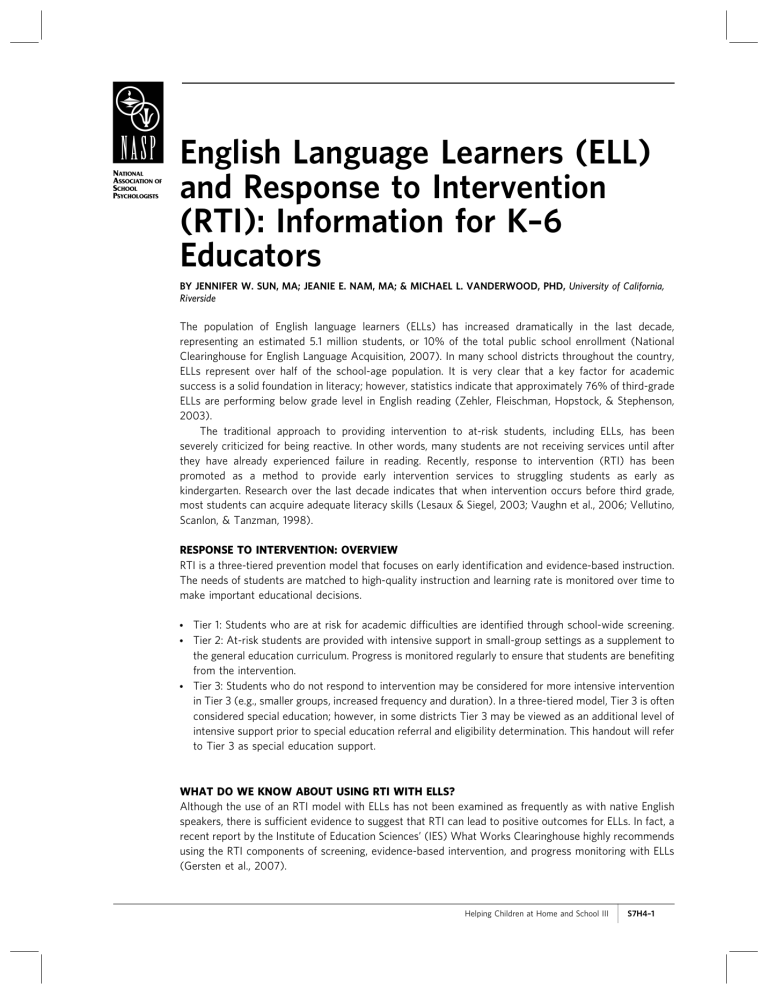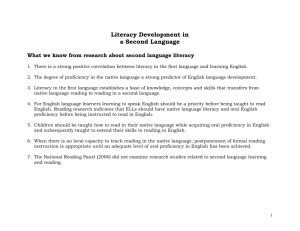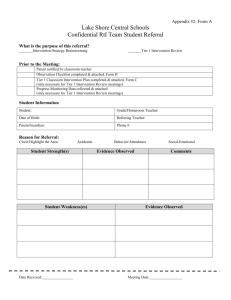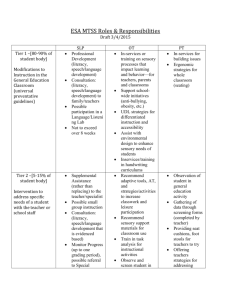English Language Learners (ELL) and Response to Intervention (RTI): Information for K–6 Educators

English Language Learners (ELL) and Response to Intervention
(RTI): Information for K–6
Educators
BY JENNIFER W. SUN, MA; JEANIE E. NAM, MA; & MICHAEL L. VANDERWOOD, PHD, University of California,
Riverside
The population of English language learners (ELLs) has increased dramatically in the last decade, representing an estimated 5.1 million students, or 10% of the total public school enrollment (National
Clearinghouse for English Language Acquisition, 2007). In many school districts throughout the country,
ELLs represent over half of the school-age population. It is very clear that a key factor for academic success is a solid foundation in literacy; however, statistics indicate that approximately 76% of third-grade
ELLs are performing below grade level in English reading (Zehler, Fleischman, Hopstock, & Stephenson,
2003).
The traditional approach to providing intervention to at-risk students, including ELLs, has been severely criticized for being reactive. In other words, many students are not receiving services until after they have already experienced failure in reading. Recently, response to intervention (RTI) has been promoted as a method to provide early intervention services to struggling students as early as kindergarten. Research over the last decade indicates that when intervention occurs before third grade, most students can acquire adequate literacy skills (Lesaux & Siegel, 2003; Vaughn et al., 2006; Vellutino,
Scanlon, & Tanzman, 1998).
RESPONSE TO INTERVENTION: OVERVIEW
RTI is a three-tiered prevention model that focuses on early identification and evidence-based instruction.
The needs of students are matched to high-quality instruction and learning rate is monitored over time to make important educational decisions.
N Tier 1: Students who are at risk for academic difficulties are identified through school-wide screening.
N Tier 2: At-risk students are provided with intensive support in small-group settings as a supplement to the general education curriculum. Progress is monitored regularly to ensure that students are benefiting from the intervention.
N Tier 3: Students who do not respond to intervention may be considered for more intensive intervention in Tier 3 (e.g., smaller groups, increased frequency and duration). In a three-tiered model, Tier 3 is often considered special education; however, in some districts Tier 3 may be viewed as an additional level of intensive support prior to special education referral and eligibility determination. This handout will refer to Tier 3 as special education support.
WHAT DO WE KNOW ABOUT USING RTI WITH ELLS?
Although the use of an RTI model with ELLs has not been examined as frequently as with native English speakers, there is sufficient evidence to suggest that RTI can lead to positive outcomes for ELLs. In fact, a recent report by the Institute of Education Sciences’ (IES) What Works Clearinghouse highly recommends using the RTI components of screening, evidence-based intervention, and progress monitoring with ELLs
(Gersten et al., 2007).
Helping Children at Home and School III
|
S7H4–1
In the past, it was believed that low English proficiency prevented ELLs from learning to read in
English. As a result, ELLs were not assessed with early reading measures until they reached adequate English proficiency. Contrary to this belief, current studies have found that the level of English language proficiency does not predict who will struggle with reading. In addition,
ELLs can be assessed using the same English early literacy screening tools that are used with their Englishonly peers (Gersten et al., 2007).
Phonological awareness.
Phonological awareness is the understanding that spoken words and syllables can be divided into smaller components or phonemes. This skill can be assessed as early as kindergarten using measures of onset-rime, segmenting, and blending. Past research suggests that phonological awareness is not a language-specific skill involved in early reading. Once phonological awareness is developed in a child’s native language, these skills can be applied to learning a second language. For example, several studies have found that
Spanish phonological awareness and word-decoding ability are significantly correlated with English phonological awareness and word reading (Quiroga, Lemos-
Britton, Mostafapour, Abbott, & Berninger, 2002).
WHAT CAN SCHOOLS DO?
Student needs are first identified in Tier 1, with increasingly intensive levels of support provided in
Tiers 2 and 3.
Tier 1
Prevention starts in Tier 1:
Letter naming fluency.
These tasks measure both the accuracy and speed with which a child can name the letters of the alphabet. Measures of letter naming fluency administered through the end of kindergarten have been found to be predictive of later reading ability
(Good & Kaminski, 2002).
N Conduct universal class-wide screening three times per year in order to identify and intervene with ELLs who are at risk for reading problems.
N Train educators to use screening data to guide instruction in the classroom.
N Assess in the areas of phonological awareness, letter naming fluency, alphabetic knowledge, and oral reading fluency.
N Screen in the language of instruction and, if possible, in the student’s native language.
Alphabetic knowledge.
This skill is a critical prerequisite to proficient reading, enabling beginning readers to sound out word segments and blend these sounds to form words (National Reading Panel, 2000). One measure of alphabetics called pseudoword reading has been found to be strongly correlated with real-word reading and comprehension for both native English speakers and ELLs (Fien et al., 2008; Swanson, Trainin,
Necoechea, & Hammill, 2003; Vanderwood, Linklater, &
Healy, 2008). Pseudoword reading measures can be used to assess alphabetic knowledge as early as the middle of kindergarten through the end of first grade.
Early literacy measures.
AIMSweb and the Dynamic
Indicators of Basic Early Literacy Skills (DIBELS) are two websites that provide grade-based early literacy measures for use in conducting screening and progress monitoring (see Recommended Resources below). These measures are individually administered, take approximately 1–3 minutes per student, and allow for educators to regularly and frequently assess whether students are making adequate progress. Schools may use locally developed district norms or previously developed benchmark criteria, which are available through DIBELS.
Oral reading fluency.
These tasks assess the speed and accuracy of text reading. An assessment of oral reading fluency can be used to make inferences about a student’s decoding skills and can also serve as a reliable and valid index of general reading achievement. Oral reading fluency has been found to be sensitive to growth over periods as short as two weeks and predictive of performance on statewide reading assessments for ELLs
(Baker & Good, 1995; Wiley & Deno, 2005). Measures of oral reading fluency can be used as early as the middle of first grade.
Benchmarks.
Gersten et al. (2007) recommend that schools apply the same benchmarks for ELLs and native
English speakers in the early grades to identify students who may be at risk, regardless of English language proficiency. In addition, past studies have found that many poor readers, including those with low levels of
English proficiency, can be brought to at least average levels of performance if they are provided with supplemental, high-quality intervention during the early stages of reading development (Lesaux & Siegel, 2003;
Vaughn et al., 2006).
Tier 2
Regardless of the level of English language proficiency, students who are identified as at risk in Tier 1 should be provided with research-supported intervention in Tier 2.
If possible, the language of the intervention should correspond with the language of classroom instruction.
The intensity of the intervention should be individualized
S7H4–2
|
English Language Learners (ELL) and Response to Intervention (RTI)
and based on several factors, such as the student’s degree of risk and his or her rate of progress.
N Provide intensive, small-group reading intervention
(3–6 students) for students who are at risk for reading problems. Form groups based on reading ability.
N Provide explicit and systematic instruction in five critical areas: phonological awareness, alphabetic knowledge, fluency, vocabulary, and comprehension.
N Emphasize development of conversational as well as academic vocabulary. Although students who speak another language develop social proficiency within the context of everyday living, cognitive academic language proficiency is dependent on formal schooling.
N Provide interactive teaching that allows for multiple opportunities to respond, with corrective feedback.
N Establish goals using district or national benchmarks.
This can be done by developing district norms based on screening data or by using previously developed benchmark criteria.
N Monitor progress regularly to ensure that students are benefiting from the intervention and meeting their goals. The same assessment tools used to identify the students in Tier 1 can be used to monitor progress in
Tier 2.
#
Establish initial goals and adjust them based on rate of growth.
#
If the student’s progress is above his or her goal line, either increase the goal or exit the student from the intervention.
#
If the student’s progress is equal to the goal line, continue the intervention.
#
If the student’s progress is below the goal, adjust the intervention.
N The frequency of progress monitoring should be determined by the severity of the problem. The general recommendation is that students at high risk for reading problems be monitored weekly or biweekly
(Gersten et al., 2007).
N Although there is not a universal standard, typical practice is to have at least 7–10 data points before the data are used to make an educational decision (Shinn,
Good, & Stein, 1990).
Tier 3
Before considering a student for special education, educators must determine whether the student’s academic difficulties more likely reflect a learning disability or limited English proficiency.
N Compare the student’s rate of progress during intervention with other students of similar English language proficiency.
N Conduct a comprehensive review of the student’s educational history, including an examination of: (a) the quality of the instruction provided in Tiers 1 and 2, and whether the instruction was matched to the student’s needs; (b) whether the critical components of literacy instruction were provided (refer to Tier 2);
(c) the intensity, including the frequency and duration, of past interventions; (d) previous progress monitoring data, including initial performance, rate of progress, and whether past goals were met; and (e) the fidelity of intervention implementation (e.g., was the intervention consistently implemented as intended?).
If it is determined that the student qualifies for Tier 3
(special education support):
N Either continue the intervention from Tier 2, with increased intensity, or develop a new intervention plan based on the student’s needs.
N Continue to monitor rate of progress frequently and regularly.
REFERENCES
Baker, S. K., & Good, R. H. (1995). Curriculum-based measurement of English reading with bilingual
Hispanic students: A validation study with secondgrade students.
School Psychology Review , 24 , 561–
578.
Fien, H., Baker, S. K., Smolkowski, K., Smith, J. L.,
Kame’enui, E. J., & Beck, C. T. (2008). Using nonsense word fluency to predict reading proficiency in kindergarten through second grade for English learners and native English speakers.
School
Psychology Review , 37 , 391–408.
Gersten, R., Baker, S. K., Shanahan, T., Linan-Thompson,
S., Collins, P., & Scarcella, R. (2007).
Effective literacy and English language instruction for English learners in the elementary grades: A practice guide . Washington,
DC: National Center for Education Evaluation and
Regional Assistance, Institute of Education Sciences,
U.S. Department of Education.
Good, R. H., & Kaminski, R. A. (2002).
Dynamic Indicators of Basic Early Literacy Skills (DIBELS) (6th ed.).
Eugene, OR: Institute for the Development of
Education Achievement.
Lesaux, N. K., & Siegel, L. S. (2003). The development of reading in children who speak English as a second language.
Developmental Psychology , 39 , 1005–1019.
Helping Children at Home and School III
|
S7H4–3
National Clearinghouse for English Language Acquisition.
(2007).
The growing numbers of limited English proficient students: 1995/96–2005/06 .
Retrieved
June 15, 2009, from http://www.ncela.gwu.edu/ files/uploads/4/GrowingLEP_0506.pdf
National Reading Panel. (2000).
Teaching children to read: An evidence-based assessment of the scientific research literature on reading and its implications for reading instruction . Retrieved June 15, 2009, from http://www.nichd.nih.gov/publications/nrp/upload/ smallbook_pdf.pdf
Quiroga, T., Lemos-Britton, Z., Mostafapour, E., Abbott,
R. D., & Berninger, V. W. (2002). Phonological awareness and beginning reading in Spanish-speaking ESL first graders: Research into practice.
Journal of School Psychology , 40 , 85–111.
Shinn, M. R., Good, R. H., & Stein, S. (1990). Summarizing trend in student achievement: A comparison of methods.
School Psychology Review , 18 , 356–370.
Swanson, L. H., Trainin, G., Necoechea, D. M., & Hammill,
D. D. (2003). Rapid naming, phonological awareness, and reading: A meta-analysis of the correlation evidence.
Review of Educational Research , 73 , 407–440.
Vanderwood, M. L., Linklater, D., & Healy, K. (2008).
Predictive accuracy of nonsense word fluency for
English language learners.
School Psychology Review ,
37 , 5–17.
Vaughn, S., Mathes, P., Linan-Thompson, S., Cirino, P.,
Carlson, C., Pollard-Durodola, S., et al. (2006).
Effectiveness of an English intervention for first-grade
English language learners at risk for reading problems.
The Elementary School Journal , 107 , 153–180.
Vellutino, F. R., Scanlon, D. M., & Tanzman, M. S. (1998).
The case for early intervention in diagnosing specific reading disability.
Journal of School Psychology , 36 ,
367–397.
Wiley, H. I., & Deno, S. L. (2005). Oral reading and maze measures as predictors of success for English learners on a state standards assessment.
Remedial and Special Education , 26 , 207–214.
Zehler, A., Fleischman, H., Hopstock, P., Stephenson, T.,
Pendzick, M., & Sapru, S. (2003). Descriptive study of services to LEP children and LEP children with disabilities: Summary of findings related to LEP and
SpEd-LEP children (Policy Report). Arlington, VA:
Development Associates, Inc.
RECOMMENDED RESOURCES
AIMSweb: http://aimsweb.com
Grade-based early literacy measures for screening and progress monitoring.
Dynamic Indicators of Basic Early Literacy Skills
(DIBELS): http://dibels.uoregon.edu
Early literacy measures for screening and progress monitoring.
Institute of Education Services (2007). Effective literacy and English language instruction for English learners in the elementary grades. Washington, DC: U.S.
Department of Education. Available: http://ies.ed.
gov/ncee/wwc/pdf/practiceguides/20074011.pdf
Recommendations for effective literacy instruction and intervention for ELLs.
National Center for Learning Disabilities (2006), A parent’s guide to response to intervention : http://www.ncld.
org/images/stories/Publications/AdvocacyBriefs/
ParentGuide-RTI/ParentsGuidetoRTI.pdf
An overview of the RTI process and how it is implemented in schools.
National Center for Progress Monitoring: http://www.
studentprogress.org
Information on progress monitoring, including a
Web library with links to current research.
National Clearinghouse for English Language Acquisition: http://www.ncela.gwu.edu
Information and resources for educators working with ELLs.
Jennifer W. Sun, MA, and Jeanie E. Nam, MA, are graduate students, and Michael L. Vanderwood, PhD, is an Associate
Professor and program director, all in the School Psychology program at the University of California, Riverside.
E 2010 National Association of School Psychologists, 4340 East West Highway, Suite 402,
Bethesda, MD 20814—(301) 657-0270
S7H4–4
|
English Language Learners (ELL) and Response to Intervention (RTI)






